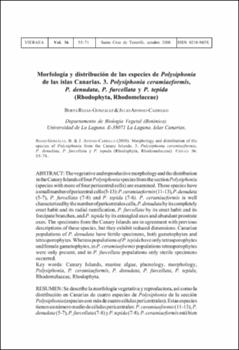Morfología y distribución de las especies de Polysiphonia de las islas Canarias. 3. Polysiphonia ceramiaeformis, P. denudata, P. furcellata y P. tepida (Rhodophyta, Rhodomelaceae)
Date
2008Abstract
The vegetative and reproductive morphology and the distribution
in the Canary Islands of four Polysiphonia species from the section Polysiphonia
(species with more of four pericentral cells) are examined. These species have
a small number of pericentral cells (5-13): P. ceramiaeformis (11-13), P. denudata
(5-7), P. furcellata (7-8) and P. tepida (7-8). P. ceramiaeformis is well
characterized by the number of pericentrales cells, P. denudata by its completely
erect habit and its radial ramification, P. furcellata by its erect habit and its
forcipate branches, and P. tepida by its entangled axes and abundant prostrate
axes. The specimens from the Canary Islands are in agreement with previous
descriptions of these species, but they exhibit reduced dimensions. Canarian
populations of P. denudata have fertile specimens, both gametophytes and
tetrasporophytes. Whereas populations of P. tepida have only tetrasporophytes
and female gametophytes, in P. ceramiaeformis populations tetrasporophytes
were only present, and in P. furcellata populations only sterile specimens
occurred. Se describe la morfología vegetativa y reproductora, así como la
distribución en Canarias de cuatro especies de Polysiphonia de la sección
Polysiphonia (especies con más de cuatro células pericentrales). Estas especies
tienen un número medio de células pericentrales: P. ceramiaeformis (11-13), P.
denudata (5-7), P. furcellata (7-8) y P. tepida (7-8). P. ceramiaeformis está bien caracterizada por el número de células pericentrales, P. denudata por su hábito
completamente erecto y ramificación radial, P. furcellata por su hábito erecto
y sus ramas forcipadas y P. tepida por sus ejes enmarañados con ejes
postrados abundantes. Los especimenes de Canarias están en general de
acuerdo con las descripciones previas de estas especies, pero exhiben
dimensiones algo más reducidas. Las poblaciones canarias de P. denudata
contienen gametófitos y tetrasporófitos fértiles. Mientras las poblaciones de
P. tepida tienen solamente tetrasporófitos y gametófitos femeninos, las de P.
ceramiaeformis sólo tetrasporófitos, y las de P. furcellata sólo especímenes
estériles.






